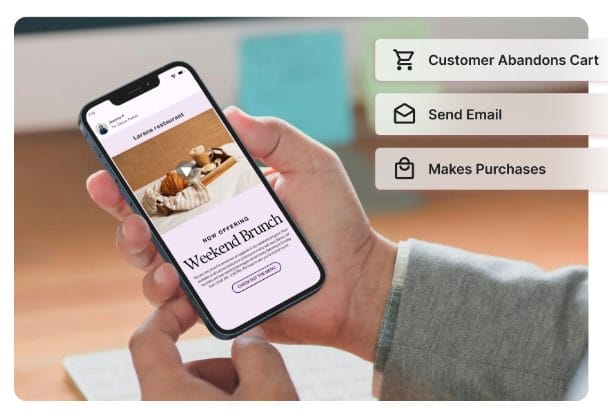Components of B2B Marketing strategies

So you have decided that inbound marketing is what your B2B company needs.
Good choice.
The next step is crafting B2B marketing strategies steps that align with and works towards your marketing goal.
Although there are several inbound marketing strategies to choose from, there are specific B2B marketing components and pillars, if you will, that hold up every effective B2B inbound marketing strategy.
Adequately considered and applied, these B2B marketing components will produce an equally effective b2b inbound marketing strategy that will guide your business toward achieving its goal.
So, let us discuss crucial components of B2B inbound marketing strategies you need to be aware of.
10 Foundational B2B Marketing Components
1. Set clear marketing goals and have key performance indicators

Clear marketing goals and KPIs are necessary if you want a successful B2B inbound marketing strategy.
Notice I said CLEAR goals, that is, SMART goals; Specific, Measurable, Attainable, Realistic, and Timely.
The goals should not be ambiguous or unclear.
Hence, a car-parts manufacturing company with a marketing goal to increase sales by 20% above last year’s profit as a SMART goal. It is clear, specific, and appears doable.
Compare this with the goal of another company which is to increase sales.
Asides from your goals, you also need to have KPIs.
These are ways to gauge your performance and quantify how well you are on your way to achieving your set marketing goals.
While it is easy to confuse KPIs with metrics, KPIs focus on measuring business performance against specific set goals that will cause expansion and growth in the company.
Metrics, on the other hand, checks the business’s general health. It may/may not be tied to specific goals vital to the company’s growth.
Using the example of the car-parts manufacturing company, such company’s KPIs will look like this:
– Monthly customer retention rate
– Monthly customer acquisition rate
– Total sales rate by monthly
– Cost per customer acquisition
– The average rate of converting potential leads to customers, etc.
2. Who is your target market?

Identifying your target market, their attributes, demographics, characteristics, etc., is vital to formulating successful b2b inbound marketing strategies to draw them in.
Identifying your target market will involve knowing the type of companies or persons you want to attract and profiling what your target client looks like.
The profiled target client for a B2B organization must represent the decision-makers in the target business and the entire company.
For instance, a paper-manufacturing company has a photocopying and printing business as its target market.
Upon conducting its market research, it profiles its target market to resemble the owner of an ideal photocopy business.
The profiling may look something like this –
– Name: Luke
– Age: 35- 45
– Monthly income: $1000 – $1500
– Hobbies: golfing, traveling, and sight-seeing
– Business: photocopy business with 250 – 300 employees and over 1000 customers
– Location: Canada and US
– Goals: grow their customer base, make a profit
– Needs: they need a reliable paper company that produces quality paper using an eco-friendly method
Having profiled its target market this way, the paper company knows what its target market needs and how to meet them.
With this information, it is easy to draw up an inbound marketing strategy that will “hook” its potential client and draw it in.
3. Research your competition

Analyzing your competitors helps you identify what kind of “weapons” your marketing strategy needs to attract and retain your market.
Profiling your competitors will help you know what kind of weapons they are already using, the pros/cons of those weapons, and how you can improve on those weapons to create your atomic bomb! – okay, too much.
But my point is this; knowing who your competition is and how you match up against them helps you know what kind of b2b inbound marketing strategies (weapons) you will need to attract and keep your potential market.
It will help you deduce what strategies your competitors are already using, their successes and shortcomings, and how you can improve on those strategies to create a unique marketing strategy that will perform better than theirs.
Done well, analyzing the competition provides factual data, which will be your launchpad for crafting unique and more-effective B2B inbound marketing steps to achieve your marketing aims.
4. Consider the different stages of a buyer’s journey

You also want to consider the steps in a buyer’s journey when drawing up your b2b inbound marketing strategy.
A buyer’s journey refers to the four phases in any buying process; awareness, consideration, decision, and experience.
Considering the phases in a buyer’s journey necessitates crafting marketing strategies that meet your potential market at whatever stage they are in their journey to ease them into the next.
Hence, your b2b inbound marketing strategies will include what a prospect in a particular phase would be interested in and what is needed to lead them to the next stage.
A target market coming across your site for the first time will probably not be interested in ringing up your customer care for more information on your products/service.
However, this may interest a market in the decision stage.
A potential client at the awareness stage is testing the waters.
What such a client needs is more relevant content that answers their question and draws them in.
Here is a list of what each stage in a buyer’s journey requires:
– Awareness stage: at this stage, you seek to establish your business as a familiar name in the mind of prospective clients. You can do this via concise content that generally outlines their pain points and points to solutions.
– Consideration stage: Here, the potential lead is familiar with your business and is starting to view it as an expert. Well-researched long-form content comprehensively discussing specific problems and solutions relevant to the potential market is offered at this stage.
– Decision stage: In this stage are potential customers who are now qualified leads ready to buy. At this stage, you need to communicate to your target client why your business is the best option for them, make irresistible offers and share success stories of past customers.
– Experience stage: clients at this stage have patronized the business. What is required at this stage is to help these customers enjoy their purchases?
You can send them FAQs, guides, reviews, etc.
5. Calculate your budget

Compared to traditional marketing, inbound marketing is cheap.
Cheap but not free.
With inbound marketing, you will need to budget for your content team salary, graphics team salary, CMS website hosting tools, market automation tools, research, etc.
Many factors determine how much a B2B can set aside as the budget for implementing its inbound marketing strategies.
And a majority of these factors revolve around the business type, its goals, and the timeframe to achieve them.
Hence, it is vital to consider these factors as they apply to your business to draw up the budget that will suit your b2b marketing needs.
6. Content – the king of inbound marketing

Knowing what to say to your potential market is necessary if you want to draw them in.
But to do this effectively, you need a good content strategy.
A good content strategy requires producing content, short-form or long-form articles, relevant to your market’s needs.
It calls for quality market research, good knowledge of content optimization, consistency in posting high-quality content, taking into account the buyers’ journey of your market, etc.
An effective B2B content strategy would cover who your company is, its solutions, how it helps your customers solve their problems, and why a potential lead should patronize you rather than your competitors.
With a solid content strategy, you will be an expert in your prospect’s minds, win their trust, build long-lasting customer relationships, and effectively guide your target clients through their buyers’ journey.
7. Apply SEO

With competition arising daily, optimizing your content to appear on the first page and possibly in the top three during an organic search is another necessary B2B inbound marketing strategy for companies seeking to draw in their market before the competition.
SEO, in full; search engine optimization helps contents rank high and making it visible on time to potential leads.
This is necessary in today’s world, where people have the attention span of a goldfish and do not go past the first page of their search entry.
In this vein, understanding the role of keywords in articles, tagging, optimizing URLs, etc., is necessary to apply SEO quickly and adequately draw in prospective market.
8. Good website layout

The state of your website is another marketing component for an effective B2B inbound marketing strategy.
If after attracting your target market, they get to your website which is full of contrasting colors that hurt the eyes or complex navigation that a simple user cannot figure out, be sure that your market will make a U-turn – Goodbye.
Hence, your website must be visually pleasing, well-organized, and user-friendly.
It should portray your brand’s personality, serious or playful, and contain relevant information your target market would want to know about the business.
9. Analyze and learn from past marketing strategies

As you craft your B2B inbound marketing strategy, look at the components of past marketing strategies you have employed and their advantages and pitfalls.
To effectively do this, you may need to ask questions like:
– Were you able to attract customers but unable to retain them under the old marketing strategy?
– Was the process too expensive to maintain?
– Were you promoting your products/services on the wrong medium?
Learning from past strategies can avoid unnecessary pitfalls when crafting your B2B inbound marketing strategy. There is also the opportunity to salvage any plan that yielded results for your business so that you do not throw away the baby with the bathwater.
10. Formulate functional conversion plans

Drawing in your target market is easy.
Converting them into qualified leads is not.
It requires patience, consistency, and dedication.
It requires fixing your eyes on the price – gaining customers for your business.
As a B2B that desires a functional inbound marketing strategy, you need well-laid-out conversion plans to nurture your target market and guide them through the sales funnel.
A functional conversion plan will include:
– Reach out to your prospect regularly and respond ASAP when they have questions.
– Applying targeted content marketing, send them contents that address specific matters relevant to them.
– Using personalized email marketing.
The goal is to get your market to trust you, such that your business is the first one that comes to mind when they are ready to make a purchase.
So yeah, I am one of those that tout inbound marketing strategy as one of the best inventions since sliced bread, especially for B2Bs.
And why not?
The marketing strategy is efficient, cheap, and worth all the stress in the long run.
Because inbound marketing thrives on customers finding a company themselves via organic search, this marketing strategy will deliver to B2B only genuine prospects; target clients genuinely interested in what you have to offer.
Properly handled, these prospects can end up being long-term customers loyal to your brand – a benefit vital to any B2B organization due to the generally limited target market for B2B.
RELATED: B2B sales Pitch in 7 steps with examples to create your own
You love this Article, right? Get more Updates via Adilo’s Twitter Page
https://shipearly.com/b2b-commerce-misconceptions/
https://wearegrow.com/b2b-marketing-strategies/
https://hygger.io/blog/formulate-apply-smart-goals-objectives/
https://www.mindinventory.com/blog/how-to-identify-target-audiences-for-mobile-app/
https://alcorfund.com/insight/competitor-research-benefits-methods-process-template/
https://i.workana.com/glossary/what-is-buyers-journey/
https://pigly.com/budget/
https://www.entrepreneur.com/article/354378
https://mangools.com/blog/learn-seo/
https://www.freepik.com/vectors/computer-component
https://www.mayple.com/blog/digital-marketing-plan-template
https://www.freepik.com/vectors/marketing-plan








